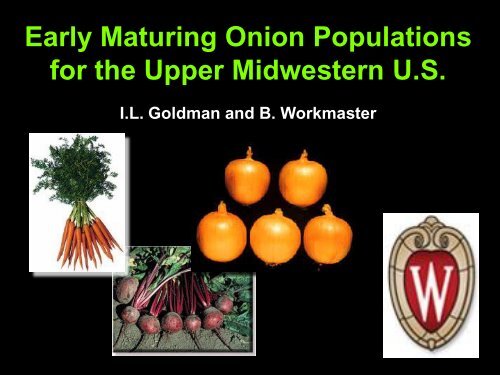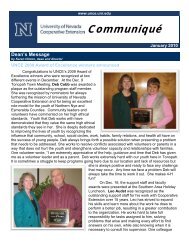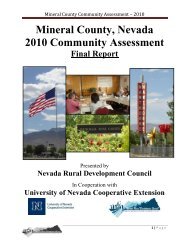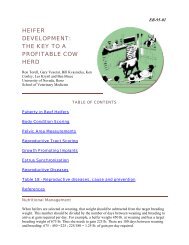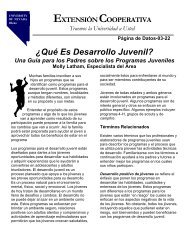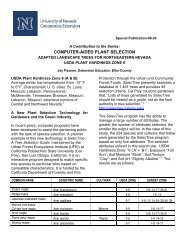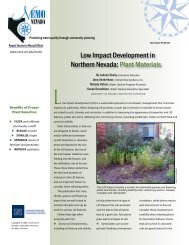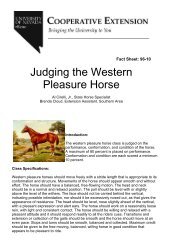Early Maturing Onion Populations for the Upper Midwestern U.S.
Early Maturing Onion Populations for the Upper Midwestern U.S.
Early Maturing Onion Populations for the Upper Midwestern U.S.
Create successful ePaper yourself
Turn your PDF publications into a flip-book with our unique Google optimized e-Paper software.
<strong>Early</strong> <strong>Maturing</strong> <strong>Onion</strong> <strong>Populations</strong><br />
<strong>for</strong> <strong>the</strong> <strong>Upper</strong> <strong>Midwestern</strong> U.S.<br />
I.L. Goldman and B. Workmaster
Our Programs<br />
• <strong>Onion</strong>, carrot, table beet<br />
• Development of inbred<br />
lines, open pollinated<br />
cultivars, and improved<br />
germplasm<br />
• Genetic research<br />
• Over 60 releases<br />
currently in use around<br />
<strong>the</strong> world
My Jobs<br />
• Professor of Horticulture<br />
and trainer in <strong>the</strong> Plant<br />
Breeding and Plant<br />
Genetics Program<br />
• Recently stepped down<br />
after 6 years in college<br />
administration<br />
• Co-organizer of <strong>the</strong><br />
annual Giant Pumpkin<br />
Regatta
7 years<br />
22 Months
Our Releases<br />
• Inbred lines and OPs<br />
• Sterile and maintainer<br />
pairs<br />
• Released by UW prior to<br />
1996, <strong>the</strong>n by WARF<br />
• Licensed by seed<br />
industry and public<br />
sector partners<br />
WAY lines
<strong>Early</strong> <strong>Onion</strong> Project<br />
• Wisconsin growers must<br />
compete with western<br />
growers and <strong>the</strong> global<br />
marketplace<br />
• <strong>Early</strong> maturity in latitudes<br />
above 38 degrees would<br />
allow <strong>for</strong> a longer market<br />
window
<strong>Early</strong> <strong>Onion</strong> Project<br />
• <strong>Early</strong> maturing long day<br />
cultivars <strong>for</strong> nor<strong>the</strong>rn<br />
latitudes range from<br />
approximately 90–105 d<br />
• Typical planting occurs<br />
from late April to <strong>Early</strong> May<br />
• May 1 – August 1 = 93 d<br />
“Ricochet is an early-maturing<br />
(95 day) onion that produces<br />
large-sized bulbs and has high<br />
yield potential”
<strong>Early</strong> Maturity<br />
• Although early maturing varieties typically have<br />
lower yields…<br />
• A 50 lb. bag could bring $0.50 to $2.00 more in<br />
mid-August than in mid-September, translating<br />
into a 10-20% differential<br />
• Shipping point prices 2007, cents / cwt, USDA<br />
July August September October<br />
16.80 13.70 12.20 10.90
<strong>Early</strong> Maturity<br />
• <strong>Early</strong> work at Wisconsin on development of early<br />
maturing onions took place in <strong>the</strong> 1950s<br />
• Crosses between long x short day types to<br />
produce cultivars like ‘<strong>Early</strong> Harvest’<br />
<strong>Early</strong> Harvest - Breeder: USDA. Parentage: B2108A x TEG951C<br />
<strong>Early</strong> Yellow Globe inbred by Texas <strong>Early</strong> Grano. Characteristics: F1<br />
hybrid, small plant size, semi-glossy foliage; bulb size intermediate,<br />
light yellow color, globe, mild, soft; very early maturity.<br />
Adaptation: all sections except sou<strong>the</strong>rn United States. Hybrid <strong>Early</strong><br />
Harvest, USDA release 1 Dec. 1953.<br />
Vegetable Cultivar Descriptions <strong>for</strong> North America <strong>Onion</strong> (A-L), Lists 1-26 Combined Edited by Michael J. Havey
<strong>Early</strong> Maturity<br />
• Since 1995, we have been<br />
selecting onion<br />
populations <strong>for</strong> early<br />
maturity<br />
• We have developed five<br />
syn<strong>the</strong>tic populations<br />
that show promise as<br />
early maturing<br />
germplasm<br />
<strong>Early</strong> <strong>Onion</strong> Syn<strong>the</strong>tics<br />
mature by late July
Our Approach<br />
Bulb Production Seed Production Syn<strong>the</strong>tic<br />
HS Families<br />
Combines syn<strong>the</strong>tic<br />
population<br />
development with recurrent<br />
selection
WEOS<br />
• The WEOS project began with evaluation of OP<br />
cultivars that showed promise <strong>for</strong> earliness<br />
• Included Imai <strong>Early</strong> Yellow, <strong>Early</strong> Cream Gold,<br />
Australian Cream Gold, M&R <strong>Early</strong>, Hustler,<br />
Northstar, Trapp’s Downing, RNX-10081, Pukekohe<br />
Longkeeper <strong>Early</strong><br />
• Also included six accessions from <strong>the</strong> USDA-NPGS<br />
collection including PI 43345, PI 264650<br />
• Inbred lines from <strong>the</strong> Wisconsin program including<br />
W446, W434 and USDA Inbred B2264
• Bulbs harvested and<br />
intercrossed in cages to<br />
<strong>for</strong>m five separate<br />
syn<strong>the</strong>tic populations<br />
• Individual inbred lines, OP<br />
selections, and PI<br />
selections crossed with<br />
one or more syn<strong>the</strong>tic<br />
populations
• An example might be<br />
{(PI264650 x W420) x<br />
<strong>Early</strong> <strong>Onion</strong> Syn<strong>the</strong>tic 1}<br />
• Multiple crosses were<br />
placed in each cage<br />
• Seed from each half-sib<br />
family was sown <strong>the</strong><br />
following year and<br />
evaluated <strong>for</strong> maturity<br />
• Obvious hybrids were<br />
selected and recombined<br />
Cages at Seminis<br />
in DeForest, WI
Population Number of Cycles Number of Families<br />
WEOS 1 7 15<br />
WEOS 2 6 10<br />
WEOS 3 6 17<br />
WEOS 4 5 1<br />
WEOS 5 4 1
WEOS<br />
• During 2009 and 2010, we compared each population<br />
in on-farm trials with 6 commercial varieties that had<br />
maturities from 90-120 days<br />
• Plots were four rows, three replications per year<br />
• Thinned to 3.8 cm spacing between plants in early<br />
June<br />
• Check cultivars were Northstar, Sherman, Trailblazer,<br />
Fortress, Nicolet, and Sedona. Nebula and Ricochet<br />
were also used in 2010
EOS 2 and EOS 3 show<br />
early maturity
EOS 5, EOS 1, and EOS 4<br />
show relative earliness
Population On August 5, 2009 On July 29, 2010<br />
WEOS 1 17% 32%<br />
WEOS 2 57% 49%<br />
WEOS 3 67% 47%<br />
WEOS 4 17% 16%<br />
WEOS 5 37% 26%<br />
<strong>Early</strong> check cultivar mean: 12% 22%<br />
Mid check cultivar mean: 5% 11%
% tops down<br />
100<br />
90<br />
80<br />
70<br />
60<br />
50<br />
40<br />
30<br />
20<br />
10<br />
0<br />
1 wk<br />
7/20 7/27 8/3 8/10 8/17<br />
EOS#1 bulked<br />
EOS#2 bulked<br />
EOS#3 bulked<br />
EOS#4 bulked<br />
EOS#5 bulked<br />
<strong>Early</strong> cv #1<br />
<strong>Early</strong> cv #2<br />
Mid cv #1<br />
Mid cv #2<br />
Late cv #1<br />
Late cv #2
Outcome<br />
• We have recombined sources of<br />
earliness in long day onion into<br />
five syn<strong>the</strong>tic populations<br />
• We have recurrently selected<br />
<strong>the</strong>se populations <strong>for</strong> early<br />
maturity in Wisconsin<br />
environments<br />
• We believe <strong>the</strong>y may be a<br />
source of earliness <strong>for</strong> o<strong>the</strong>r<br />
long day onion breeding<br />
programs
Release<br />
• These are not finished lines or<br />
cultivars<br />
• Ra<strong>the</strong>r, it is our intent to make<br />
<strong>the</strong>se populations available as<br />
germplasm <strong>for</strong> breeding<br />
• Released through Wisconsin<br />
Alumni Research Foundation<br />
• The manager of this germplasm<br />
is Emily Bauer, emily@warf.org
Acknowledgements<br />
And Scott Hendricks of Seminis Vegetable Seeds
https://mywebspace.wisc.edu/groups/Goldman/Web


